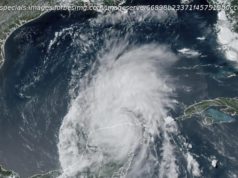Ida is expected to strike Louisiana on Sunday, the anniversary of Hurricane Katrina, possibly as a Category 4 storm.
Read our latest coverage of Hurricane Ida. …
Ida is expected to strike Louisiana on Sunday, the anniversary of Hurricane Katrina, possibly as a Category 4 storm. Read our latest coverage of Hurricane Ida. Hurricane Ida is swiftly heading for landfall in the United States. Here’s the latest on Hurricane Ida’s path. Covid surge complicates preparations in Louisiana for Hurricane Ida. transcript Just look at these rains. Intense, intense rains. Less than 12 hours after forming, Hurricane Ida passed through the Cayman Islands at tropical storm strength. By the time it made landfall in Cuba later on Friday, it had become a Category 1 hurricane. Now the storm is in the Gulf of Mexico, with Louisiana in its sights. Ida could strike the state as a Category 4 hurricane — with maximum sustained winds of 140 miles per hour — Sunday, the 16th anniversary of Hurricane Katrina. Louisiana was also battered by several storms last year, including Hurricanes Laura and Delta. On Saturday, there was a hurricane warning by the National Hurricane Center in effect from Intracoastal City, La., to the mouth of the Pearl River, a region that includes New Orleans. Storm surge warnings were issued as well. The center said that, depending on the tides, the surge could be as high as 15 feet in Morgan City, La., and reach up to 7 feet in Lake Pontchartrain. “Ida is expected to be an extremely dangerous major hurricane when it reaches the coast of Louisiana,” the center said, adding, “Actions to protect life and property should be rushed to completion in the warning area.” Ida had maximum sustained winds of 80 miles per hour after leaving Cuba. The crucial question, for residents and emergency authorities along the Gulf Coast, is how much stronger it will become before making landfall in the United States. The hurricane center said the storm could grow much stronger very rapidly, becoming a major hurricane — defined as Category 3 or higher, with maximum sustained winds of at least 111 m.p.h. — in the 24 hours before landfall. A map showing the storm’s route as it moves toward the Gulf Coast. Research over the past decade has found that, on average, such rapid intensification of hurricanes is increasing, in part because the oceans, which provide the energy for hurricanes, are getting warmer as a result of human-caused emissions of greenhouse gases. But Ida will also strengthen quickly because the Gulf, as is usual at the end of the summer, is very warm. The hurricane center defines rapid intensification as at least a 35-m.p.h. increase in sustained winds over 24 hours. In the extremely active 2020 season, Hurricane Laura intensified by 45 m.p.h. in the 24 hours before making landfall in Louisiana as a Category 4 storm in late August. The National Hurricane Center said Ida was likely to produce heavy rainfall late Sunday into Monday from southeast Louisiana to coastal Mississippi and Alabama. Tropical storm force winds will arrive along the coast as early as Saturday night, according to the National Weather Service, before the storm makes landfall on Sunday afternoon or evening. After moving inland, the storm could contribute to flooding in Tennessee, where flash flooding killed 20 people last weekend. “Based upon current track and strength of Ida, this storm will test our hurricane protection systems in a way they haven’t been tested before,” Chip Kline, executive assistant to the governor of Louisiana for coastal activities, said on Twitter. “It’s times like these that remind us of the importance of continuing to protect south Louisiana.” Because of an editing error, an earlier version of this article misidentified the location of Tropical Storm Ida. It was in the Caribbean Sea early Friday, not the Gulf of Mexico. — Henry Fountain and Adam Sobel A map showing the storm’s route as it moves toward the Gulf Coast. In Louisiana, where daily deaths from Covid reached their highest levels this week, stretched hospitals are having to modify the intense preparations they would normally make ahead of an expected strike from Hurricane Ida. Louisiana’s medical director, Dr. Joseph Kanter, asked residents on Friday to avoid unnecessary emergency room visits to preserve the state’s hospital capacity, which has been vastly diminished by its most severe Covid surge of the pandemic. And while plans exist to transfer patients away from coastal areas to inland hospitals ahead of a hurricane, this time “evacuations are just not possible,” Gov. John Bel Edwards said at a news conference. “The hospitals don’t have room,” he said. “We don’t have any place to bring those patients — not in state, not out of state.” The governor said officials had asked hospitals to check generators and stockpile more water, oxygen and personal protective supplies than usual for a storm. The implications of a strike from a Category 4 hurricane while hospitals were full were “beyond what our normal plans are,” he added. Mr. Edwards said he had told President Biden and Deanne Criswell, the administrator of the Federal Emergency Management Agency, to expect Covid-related emergency requests, including oxygen. The state’s recent wave of Covid hospitalizations has exceeded its previous three peaks, and staffing shortages have necessitated support from federal and military medical teams. On Friday,2,684 Covid patients were hospitalized in the state. This week Louisiana reported its highest ever single-day death toll from Covid — 139 people. Oschner Health, one of the largest local medical systems, informed the state that it had limited capacity to accept storm-related transfers, especially from nursing homes, the group’s chief executive, Warner L. Thomas, said. Many of Oschner’s hospitals, which were caring for 836 Covid patients on Friday, had invested in backup power and water systems to reduce the need to evacuate, he said. The pandemic also complicated efforts to discharge more patients than usual before the storm hits. For many Covid patients who require oxygen, “going home isn’t really an option,” said Stephanie Manson, chief operating officer of Our Lady of the Lake Regional Medical Center in Baton Rouge, which had 190 Covid inpatients on Friday,79 of them in intensive care units. The governor said he feared that the movement of tens or hundreds of thousands of evacuees in the state could cause it to lose gains made in recent days as the number of new coronavirus cases began to drop. Dr. Kanter urged residents who were on the move to wear masks and observe social distancing. Many of the state’s testing and vaccination sites were slated to close temporarily. — Sheri Fink With Hurricane Ida likely to bring powerful winds and heavy rain to their city, residents of New Orleans faced a familiar choice: flee or hunker down for the duration.






